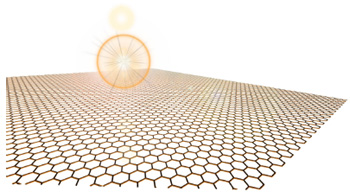Jun 7 2011
Graphene, a layer of carbon atoms only one-atom thick but about 200 times stronger than steel, is also one of the best electrical and thermal conductors on earth. In spite of the impressive list of promising prospects, graphene has a darker side: it does not have a band-gap, once it is conducting it cannot be switched-off. This lack of switching capability hinders applications in active electronic devices where the ability to switch it on and off is crucial.
Now, a team of researchers at the National University of Córdoba (Argentina), ICN (Barcelona, Spain) and RWTH (Aachen, Germany), suggest that illuminating graphene with a mid-infrarred laser could be a key to switch-off conduction, thereby improving the possibilities for novel optoelectronic devices.
 Schematic of a graphene sheet illuminated by a laser.
Schematic of a graphene sheet illuminated by a laser.
In an article featured this week in Applied Physics Letters, researchers from the National University of Córdoba report on the first atomistic simulations of electrical conduction through a micrometer-sized graphene sample illuminated by a laser field. Their simulations show that a laser in the midinfrared can open an observable bandgap in this otherwise gapless material. “Imagine that by turning-on the light, graphene conduction is turned-off or viceversa. This allows the transduction of optical into electrical signals” says Luis Foa Torres, the researcher leading this collaboration who adds: “The problem of graphene interacting with radiation is also of current interest for the understanding of more exotic states of matter such as the topological insulators. Indeed, it is expected that, under certain conditions, a graphene sample illuminated by a laser behaves as a topological insulator”.
These results are timely due to the surge of interest on radiation-induced effects on graphene, as shown by the large number of preprints appearing during the last weeks by research groups worldwide.
Full text: Hernán L. Calvo, Horacio M. Pastawski, Stephan Roche, and Luis E. F. Foa Torres, Applied Physics Letters, 98, 232103 (2011); DOI: 10.1063/1.3597412 http://link.aip.org/link/?APL/98/232103